List of the bishops of Eichstätt
The list of the bishops of Eichstätt contains an overview of the bishops of the diocese of Eichstätt or, up to the secularization of 1802, also the prince-bishops of the Hochstift Eichstätt .
The diocese of Eichstätt was and is, along with the diocese of Bamberg and the diocese of Würzburg, one of the dioceses in the Franconian region in the transition to Bavaria . As a suffragan diocese , the diocese of Eichstätt is now subordinate to the archdiocese of Bamberg . Bishops often came from the Frankish and Bavarian noble families . Often these also belonged to the high nobility (see e.g. list of high nobility families in Franconia ). The prince-bishops' spiritual career often began as the canons of Eichstätt , but not infrequently also in neighboring dioceses, where they worked asCanons , provosts or membership in the cathedral chapter .
With the adoption of coats of arms for noble families with a permanent family name based on an ancestral castle, an individual coat of arms was also created for the prince-bishops. The individual coat of arms was usually quartered . It alternated between the coat of arms of the diocese and the family coat of arms. The diocese coat of arms represented a golden bishop's staff on a red background. Variants of this coat of arms are coats of arms depictions with a heart shield or a paired arrangement of the two coats of arms mentioned. In the course of secularization at the beginning of the 19th century, commoners also achieved the dignity of bishops. In a transitional phase they were awarded the staff nobility in Bavaria , and coats of arms became unusual and lost their meaning. If the prince-bishop's coat of arms cannot be shown in the list, the family coat of arms was used, usually from the early part of Scheibler's coat of arms from the end of the 15th century and from Johann Siebmacher's coat of arms from 1605.
An essential source, especially for the early history of the diocese, is the Pontifical Gundekarianum . It was created by Bishop Gundekar II († 1075) and continued by his successors until the end of the 17th century. Noteworthy are the many miniature paintings contained , which illustrate historical processes, also retrospectively to the founding phase of the diocese in the 8th century.
List of the bishops of Eichstätt
| No. | bishop | from | to | description | presentation | coat of arms |
|---|---|---|---|---|---|---|
| 1 | St. Willibald | 741 | 787? | The canonized Willibald was an Anglo-Saxon missionary who first went on a pilgrimage through Europe to the Holy Land , later he stayed at the Montecassino monastery . Pope Gregory III sent him to missionary work in Franconia, where Willibald's brother Abbot Wunibald and sister Abbess Walburga also worked. He was a contemporary of Saint Sola . The picture shows Willibald as a work by Loy Herring from the 16th century. |
 Statue in the cathedral of Eichstätt, 16th century |
|
| 2 | Gerhoh | 787? | 806? | Gerhoh was presumably appointed directly by Willibald as his successor bishop. He moved in the goods of the Heidenheim monastery to strengthen the diocese. The Herrieden Monastery was founded at this time. | ||
| 3 | Agan | 806? | 822? | Agan and his two successors presumably also came from the influential Bavarian count family of the Roninger . Wilhelm Störmer and Stefan Weinfurter support the thesis of this origin and assume that Eichstätt can be regarded as the house diocese of this family at this point in time . | ||
| 4th | Adalung | 822? | 837? | Adalung received the diploma from Ludwig the Pious and is documented in individual documents. The saint and abbot Deocar died before 826. | ||
| 5 | Altwin | 837? | 847? | Altwin was possibly the nephew of the Regensburg bishop Adalwin . Around 838/839 he allowed the deacon Gundram, administrator of the Solnhofen monastery, to open Sola's grave in order to transfer him to a more dignified place. | ||
| 6th | Otgar | 847? | 880? | Otgar was probably Gozbald's next abbot of Niederaltaich monastery . For his services in the fight against the Bohemians he received territories from Ludwig the German , which he was able to swap with the Regensburg Bishop Embricho in closer areas near Neuburg an der Donau and Egweil . Otgar arranged for the bones of Abbess Walburga to be transferred from the collegiate church in Heidenheim to today's Sankt Walburg monastery in Eichstätt . | ||
| 7th | Gottschalk | 880? | 882? | Gottschalk is not documented in any documents, only the Pontifical Gundekarianum and the Anonymus von Herrieden testify to his short time as bishop. | ||
| 8th | Erchanbald | 882? | 912 | Erchanbald probably received for his support Arnulf's possessions for the initially poorly equipped diocese, including the Herrieden estate . In addition, there were apparently Babenberg possessions as a result of the Babenberg feud , which devastated the neighboring diocese of Würzburg . Eichstätt received the first walling. The cathedral cleric Wolfhard von Herrieden wrote a martyrology and a book about the Monheim Walpurgis miracles on behalf of Erchanbald . |
 Representation in the Pontifical Gundekarianum 11th century |
|
| 9 | Odalfried | 912 | 933 | Odalfried was the notary of King Ludwig the child and Konrad I. In the dispute between Konrad I and Arnulf the Evil , he switched to Arnulf's side. He owned property in Sinzing , some of which he left to the diocese at the end of his life. |

|
|
| 10 | Starchand | 933 | 966 | Installed by the Bavarian Duke Arnulf I , Starchand was later in the retinue of Otto the Great . According to a medieval source, the Anonymous von Herrieden , he was buried by his friend, Bishop Ulrich von Augsburg . | ||
| 11 | Reginold | 966 | 991 | Reginold attended several synods in the empire. He expanded the Eichstätter Dom and moved Willibald to a specially built extension. He wrote Officia , which were praised very early for their fluency in ancient languages . | ||
| 12 | Megingaud | 991 | 1015? | Megingaud was a noble relative of Heinrich II. When the diocese of Bamberg was founded in 1007, unlike the Würzburg bishop Heinrich I , he was able to refuse to assign territory. | ||
| 13 | Gundekar I. | 1015? | 1019 | Gundekar I was the first Eichstätt bishop of low aristocratic origin. His appointment was presumably linked to the condition of ceding territories to the newly founded diocese of Bamberg in 1007 . The south of the Radenzgau was affected , primarily to the right of the Pegnitz . |
 Representation in the Pontifical Gundekarianum 11th century |
|
| 14th | Walther | 1020 | 1021 | Walther was used by Heinrich II . After a synod that was important for the recognition of the newly founded diocese of Bamberg , he followed the emperor to Italy, where he died on the way near Ravenna and was buried in Ravenna. |
 Representation in the Pontifical Gundekarianum |
|
| 15th | Heribert | 1022 | 1042 | Heribert, who was probably considering moving the bishop's seat to Neuburg an der Donau , introduced numerous changes in Eichstätt. The construction activities included the start of the new construction of the Eichstätter Dom , the renewal of the city wall and the construction of the Sankt Walburg monastery . |
 Representation in the Pontifical Gundekarianum |
|
| 16 | Gezemann | 1042 | 1042 | Gezemann was the brother of the predecessor Heribert . He was bishop for only a few months. As Conradines the brothers were nephews of bishops Henry I of Würzburg and Heribert of Cologne and with the abbot and scholar Williram of Ebersberg related. |
 Representation in the Pontifical Gundekarianum |
|
| 17th | Gebhard I. | 1042 | 1057 | Gebhard I was cognatically related to the Salian royal family and was an important support for Henry III. in imperial politics. As imperial administrator and from 1055 as Pope Viktor II , he had supraregional importance. |
 Representation in the Pontifical Gundekarianum |
|
| 18th | Sel. Gundekar II. | 1057 | 1075 | Gundekar II had the pontifical Gundekarianum named after him built , which his successors continued to write until the end of the 17th century. In the entries he documented his 126 consecrations of churches, many of them also located in the neighboring dioceses. The Eichstätter Dom was rebuilt by him. |
 Representation in the Pontifical Gundekarianum |
|
| 19th | Udalrich I. | 1075 | 1099 | Udalrich I held in the investiture dispute with Emperor Heinrich IV. At the synods in Worms in 1076 and 1085 he broke away from Pope Gregory VII and supported the antipope Clement II. | ||
| 20th | Eberhard I. Count of Hildrizhausen | 1099 | 1112 | Eberhard I. came from the noble free von Hildrizhausen family . Through his mother Beatrix, a daughter of Otto von Schweinfurt , property around Schweinfurt came to the diocese. His brother Otto, who went blind, was accepted as a monk in the Hirsau monastery . | ||
| 21st | Udalrich II. | 1112 | 1125 | Udalrich II is occasionally documented at meetings of importance in terms of imperial politics. a. at the wedding of Henry V and Matilda of England . His father Friedrich I was the bailiff of Regensburg, related to the von Bogen family . | ||
| 22nd | Gebhard II. Count of Grögling | 1125 | 1149 | Gebhard II can be traced back to several diets and synods. The return of the Heidenheim monastery to a monastery still put his successors in distress. | ||
| Whale fountain | 1149 | 1149 | Walbrun was elected as counter-bishop at the same time as Burchard by a minority friendly to the Staufers. His supporters in the cathedral chapter also expected a continuation of the policy of his predecessor Gebhard II. Count von Grögling with regard to the Heidenheim monastery . Conrad III. decided in favor of Burchard on his return from the Second Crusade . | |||
| 23 | Burchard | 1149 | 1153 | Burchard was elected by the majority in a schismatic election and prevailed against the Staufer-friendly Dompropst Walbrun . His politics in the monastery of Heidenheim brought him to Pope Eugene III. in resentment and led, with the consent of Friedrich Barbarossa, to his removal by legates sent. | ||
| 24 | Konrad I. von Morsbach | 1153 | 1171 | Konrad I was Friedrich Barbarossa's follower and was often near him, so he was present at the wedding with Beatrix of Burgundy and accompanied Friedrich to Italy. For his services he received the Rebdorf estate , which became an essential pillar of the bishopric. Konrad I was also buried in the collegiate church there. | ||
| 25th | Egelolf | 1171 | 1182 | Egelolf appeared at short notice in Friedrich Barbarossa's entourage . He resigned due to a stroke in 1182 and died in 1189. | ||
| 26th | Otto | 1182 | 1196 | Otto held at least four diocesan synods and consecrated 105 churches and altars according to the Pontifical Gundekarianum . |
 Representation in the Pontifical Gundekarianum |
|
| 27 | Hartwig Count von Grögling-Dollnstein | 1196 | 1223 | Hartwig was another bishop from the house of the Counts of Grögling-Hirschberg . He was in the wake of the partly competing kings Philip of Swabia , Otto IV and Friedrich II. He took part in the Fifth Crusade . |

|
|
| 28 | Friedrich I of Haunstadt | 1223 | 1225 | Friedrich I was favored by the Counts of Grögling-Hirschberg , but had to assert himself as early as 1223 against his future successor Heinrich I von Zipplingen . Despite enfeoffment by King Heinrich VII and confirmation by the Mainz Bishop Siegfried II von Eppstein , representatives of Pope Honorius III. the election was invalid and Friedrich I died without consecration. | ||
| 29 | Heinrich I of Zipplingen | 1225 | 1228 | Mörnsheim Castle owes its first documentary mention to Heinrich I. The bishop was on several trips in the entourage of King Henry VII. |

|
|
| 30th | Heinrich II of Dischingen | 1228 | 1231 | There is little evidence of Heinrich II in sources. He was in opposition to the election of Friedrich I von Haunstadt and, as bishop, was a supporter of Ludwig des Kelheimer . | ||
| Hermann von Schillingsfürst | 1232 | 1232 | Hermann was as counter-bishop at the same time with Heinrich III. elected by Ravensburg , who prevailed. The decision was reached in negotiations in Rome. | |||
| 31 | Henry III. from Ravensburg | 1232 | 1237 | Henry III. came from the Würzburg ministerial family of Ravensburg . Several family members were considered to be primarily responsible for the murder of Würzburg Bishop Konrad von Querfurt . In 1212 Heinrich III tried. Bishop Otto I von Lobdeburg , a relative of Konrad, to dispute the bishop's seat. In a tense time of opposing kings and opposing bishops , he excommunicated as Eichstätter bishop the Count of Dollnstein-Hirschberg in the struggle for sovereignty. | ||
| 32 | Friedrich II of Parsberg | 1237 | 1246 | Friedrich II, who is also known as von Beratzhausen, was excommunicated by the papal ambassador Albert Behaim for his friendly attitude towards the emperor, as was the cathedral chapter standing by him. Nevertheless, he survived this unscathed. A dispute with the Count of Dollnstein-Hirschberg , who even temporarily expelled him from Eichstätt, ultimately ended in concessions from the Count to the bishop. The picture shows a tombstone dedicated to him from the end of the 16th century. |
 Grave slab 16th century |
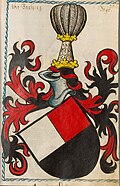
|
| 33 | Heinrich IV. Count of Württemberg | 1247 | 1259 | Heinrich IV. From the House of Württemberg was a loyal supporter of Pope Innocent IV and supported him locally in the dispute with Emperor Friedrich II. The city of Eichstätt joined the Rhenish Association of Cities in 1256 and used its own city seal for the first time. | ||
| 34 | Engelhard von Dolling | 1259 | 1261 | Engelhard took part in the provincial synod held in Mainz by Werner von Eppstein on behalf of Pope Alexander IV at the beginning of May 1261 . The priority was the rapidly expanding Mongol Empire and the threat it posed. Engelhard died during the Synod and, after a necrology of unknown origin, was probably buried in the Mainz Cathedral . | ||
| 35 | Hildebrand of Carrots | 1261 | 1279 | Hildebrand was a persistent patron of the mendicant orders . Already as an elect he allowed the Dominicans of Regensburg to preach in the diocese. He supported the monastery Schönthal the Augustinians and the Augustinian Abbey Nuremberg with the granting of indulgences - as well the construction of the Franciscan monastery Nuremberg . The Franciscan monastery in Ingolstadt and the Dominican monastery in Eichstätt received further benefits . | ||
| 36 | Reinboto von Meilenhart | 1279 | 1297 | Reinboto succeeded in further rounding off the territory of the bishopric through several acquisitions and sales of more distant properties. | ||
| 37 | Konrad II of Pfeffenhausen | 1297 | 1305 | At first, Konrad II was not only active as a canon in Eichstätt, but also a Regensburg canon and employee in the office of Ludwig the Strict . Vogt Gebhardt VI. von Hirschberg bequeathed large parts of his county to the bishopric, which also entailed the assumption of debts and negotiations about claims of the neighboring rulers. |
 Grave monument in Eichstätter Cathedral |
|
| 38 | John I of Strasbourg | 1305 | 1306 | Johann I was selected by the cathedral chapter, who as Chancellor Albrecht had close ties to the king. He should secure the Hirschberg legacy for the bishopric. As part of the negotiations for the imperial coronation in Lyon, he became Pope Clement V but the bishop of Strasbourg appointed. |
 Representation in the Pontifical Gundekarianum |
|
| 39 | Philipp von Rathsamhausen | 1306 | 1322 | Philipp came from the Alsatian nobility and was abbot of the Pairis monastery . As a companion and advisor to German kings, you can find him on trips within Europe and at important meetings of imperial political importance. Despite territorial successes, especially the integration of the Hirschberg property, the diocese's debts increased. |
 Representation in the Pontifical Gundekarianum |

|
| 40 | Marquard I of Hagel | 1322 | 1324 | As a canon, Marquard I founded the collegiate monastery of Our Lady in Eichstätt . He was administrator in the diocese since 1316 . He contributed to the fact that the bishopric was formed into a closed territory and had the first fief book drawn up. | ||
| 41 | Gebhard III. Count of Graisbach | 1324 | 1327 | As the last of the family of the Counts of Lechsgemünd-Graisbach was Gebhard III. a loyal follower of Ludwig the Bavarian and even accepted the excommunication by Pope Johannes XXII. on yourself. On his Italian campaign he anointed Ludwig king of Lombardy . He died of a plague-like illness at the gates of the besieged city of Pisa and was buried in the monastery Chiesa di San Frediano . |

|
|
| 42 | Friedrich III. Landgrave of Leuchtenberg | 1328 | 1329 | Friedrich III. was as abbot of the monastery Ebrach by Pope Johannes XXII. appointed bishop but rejected by the population. He was forced to choose Holnstein Castle near Berching as his place of residence, where he also died. He was buried in the crypt of the Landgraves von Leuchtenberg in the Waldsassen monastery church . In the 16th century, Kaspar Brusch and Wiguleus Hund reported about his grave. |
 Representation in the Pontifical Gundekarianum |
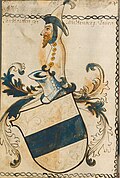
|
| 43 | Heinrich V. Schenk von Reicheneck | 1329 | 1344 | The time of Henry V was marked by the dispute between Ludwig the Bavarian and Popes John XXII. and Benedict XII. (see also Kurverein von Rhense ). His uncle Werntho Schenk von Reicheneck was initially at the same time elect of the Bamberg diocese. | ||
| 44 | Albrecht I of Hohenfels | 1344 | 1353 | Albrecht I was not ordained bishop and always signed himself as an elect . With the election of Berthold von Zollern by the cathedral chapter in 1351 , the retreat of Albrecht I began, which was finally resigned in 1353. He died in 1355. | ||
| 45 | Berthold von Zollern | 1351 | 1365 | Berthold came from the Zollern family of the neighboring burgraviate of Nuremberg . The influence of the family in the region also increased with his brother Friedrich as Bishop of Regensburg . Berthold had initially embarked on a career as Land Commander of Franconia in the Teutonic Order . From 1351 he gradually took over the tasks of his predecessor Albrecht I von Hohenfels , who finally retired in 1353. |
 Medieval votive picture in the Heilsbronn monastery church |

|
| 46 | Raban Truchseß from Wilburgstetten | 1365 | 1383 | Raban was promoted to bishop at the set age of 70. In addition to various peace alliances, he made a name for himself by consolidating the diocese's finances. |
 Representation in the Pontifical Gundekarianum |

|
| 47 | Friedrich IV. Count of Oettingen | 1383 | 1415 | The construction work on Eichstätter Dom was completed under Friedrich IV , so that it could be inaugurated again in 1396. |
 Representation in the Pontifical Gundekarianum |

|
| 48 | Johann II of Heideck | 1415 | 1429 | Johann II was involved in the Hussite Wars with religious conviction . Initially an opponent of the Bavarian Duke Ludwig VII, he negotiated an armistice among the warring parties at the insistence of the King during the Bavarian War . Due to an economical policy, the diocese became debt-free and free of pledges. |
 Grave monument in the cathedral |
 Family coat of arms according to Scheibler's book of arms |
| 49 | Albrecht II of Hohenrechberg | 1429 | 1445 | The clashes with the Hussites continued under Albrecht II. He sold enclaves of his property and acquired new castles and reinforced existing fortifications. |
 The bishop on a later epitaph (1552) |
 Family coat of arms according to Siebmacher's coat of arms book |
| 50 | Johann III. by Eych | 1445 | 1464 | Johann III. has gained importance as a humanistic reformer of monasteries, also beyond the diocesan borders. He stood u. a. in contact with scholars like Albrecht von Eyb or Hartmann Schedel . The diocese itself became involved in the numerous disputes between Albrecht Achilles and Ludwig the Rich . |
 Representation in the Pontifical Gundekarianum |

|
| 51 | Wilhelm von Reichenau | 1464 | 1496 | Wilhelm made use of the emerging printing press to bring Christian scriptures into circulation. Contrary to some poorly documented epochs, he has been recorded in numerous individual activities, including mediating in local conflicts and traveling through Europe on diplomatic trips. |
 Representation in the Pontifical Gundekarianum |
 Family coat of arms according to Siebmacher's coat of arms book 
|
| 52 | Gabriel from Eyb | 1496 | 1535 | After two decades of quiet work as a bishop in which Gabriel was also able to employ well-known local artists such as Loy Hering or Lucas Cranach the Younger , his time as bishop was nevertheless shaped by the social upheavals that the Reformation and the Peasants' War brought with it. He was in contact with Dr. Johannes Eck , one of Martin Luther's early critics . The peasant uprisings in the western bishopric were put down by the Ansbach margrave . |
 Epitaph in Eichstätt Cathedral |
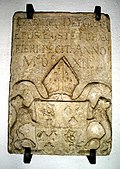 Episcopal coat of arms on a coat of arms stone |
| 53 | Christoph Marschall von Pappenheim | 1535 | 1539 | Christoph came from the von Pappenheim family , who with Georg von Pappenheim as bishop of Regensburg or with Matthäus von Pappenheim got into high spiritual offices in the region. |
 The bishop on his epitaph in the cathedral |
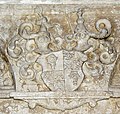 Episcopal coat of arms from its epitaph in the cathedral |
| 54 | Moritz von Hutten | 1539 | 1552 | Moritz dealt with the consequences of the Reformation for the diocese. The number of his parishes had shrunk to around a third. On the one hand he fought against the further spread of Lutheranism, on the other hand he also took action against the grievances within his church. |
 Section from the Hohenrechberg epitaph |
 Bishop's coat of arms on the Hohenrechberg epitaph |
| 55 | Eberhard II of Hirnheim | 1552 | 1560 | Eberhard II came from the Swabian noble family of Hürnheim , which went out a little later in the 16th century. |
 Bishop's coat of arms on its epitaph in the cathedral |
|
| 56 | Martin von Schaumberg | 1560 | 1590 | When Martin became bishop, two thirds of the diocesan area had become Protestant. To bring about changes he founded the Collegium Willibaldinum in 1564 . The introduction of the Gregorian calendar at the beginning of 1583 was also progressive . He carried out extensive construction work on the Willibaldsburg . In Eichstätter Dom is found to this day his mannerist Epitaphaltar . |
 Depiction on the epitaph altar |
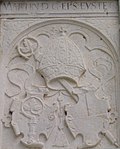 Episcopal coat of arms in Hirschstein Castle |
| 57 | Kaspar von Seckendorff | 1590 | 1595 | Kaspar came from the Frankish noble family of the Seckendorff . At the end of his life, his successor Johann Konrad von Gemmingen stood by his side as coadjutor . |
 Representation on the grave slab |

|
| 58 | Johann Konrad von Gemmingen | 1595 | 1612 | Johann Konrad had been by his predecessor Kaspar von Seckendorff as coadjutor since 1593 . He is considered a cautious and pragmatic politician who, out of consideration for his neighbors, did not join the Catholic League . As a patron of the arts, the pompous monstrance he commissioned is legendary and the gardens he laid out in Eichstätt also became famous. |

|

|
| 59 | Johann Christoph von Westerstetten | 1612 | 1637 | Johann Christoph was initially Prince Provost of Ellwangen (1603–1613). As a bishop in the Thirty Years' War , he was concerned with the destruction of the war, such as the city fire set by the Swedes in 1634 . He is one of the notorious Franconian witch bishops. |
 Representation on the grave slab |

|
| 60 | Marquard II. Count Schenk von Castell | 1637 | 1685 | Marquard II did well with the reconstruction after the Thirty Years War and also initiated an internal reorganization. |

|

|
| 61 | Johann Euchar Count Schenk von Castell | 1685 | 1697 | With Johann Euchar, another family member of the von Castell taverns came to the bishopric. The bishop also tried to generate economic impetus with other important construction contracts. His time was overshadowed by a longstanding illness to which he finally succumbed. | ||
| 62 | Johann Martin von Eyb | 1697 | 1704 | Johann Martin set new guidelines for clerical formation. During the War of the Spanish Succession , he had to flee from the French to Herrieden Monastery and on to Forchheim Fortress . |
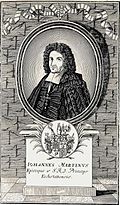 Depiction on an engraving |
 Episcopal coat of arms on the west wing of the Eichstätt residence |
| 63 | Johann Anton I. Knebel von Katzenelnbogen | 1705 | 1725 | Johann Anton I led a luxurious life in the style of an absolutist ruler and brought the diocese into financial difficulties through a corrupt administration. On the other hand, it also promoted cultural life, be it through court music, the expansion of the court library or the construction of magnificent baroque buildings. |
 Separate epitaph for the bishop's heart |

|
| 64 | Franz Ludwig Freiherr Schenk von Castell | 1725 | 1736 | Franz Ludwig renewed the bishopric administration. He organized sweeping court parties and court hunts. |

|
|
| 65 | Johann Anton II Baron von Freyberg | 1736 | 1757 | During the time of Johann Anton II, the diocese celebrated its millennium in September 1745. On this occasion, the Willibald altar was erected in the rococo style in Eichstätter cathedral . |

|

|
| 66 | Raymund Anton Count von Strasoldo | 1757 | 1781 | Raymond Anton came from the ancient nobility of Friuli and was educated at the imperial court in Vienna. With his appointment, Eichstätt positioned himself on the side of Austria in the Seven Years' War . Due to poor harvests, the bishop imported grain and also gave it to the poor at a reduced price. His social commitment in this regard was extremely remarkable for his time. |
 Depiction on a painting by Johann Michael Franz |
 Episcopal coat of arms in Hirschberg Castle |
| 67 | Johann Anton III. Baron von Zehmen | 1781 | 1790 | Johann Anton III. came from the Meissnian-Saxon family of von Zehmen . Its epitaph altar still adorns the Eichstätter cathedral today. He led an enlightened reform in the Principality of Eichstätt, which included the reduction of national debt, the improvement of administration, made industry and agriculture more effective, reformed welfare for the poor and the school system, and introduced fire protection insurance. After the election, Johann Anton III von Zehmen was considered a compromise or transition candidate due to his old age and frailty. Zehmen “avenged himself” on the skeptics, - as Franz Xaver Heinrichmayer, one of his biographers, put it - that he “only marked his years in government with good deeds and with so many wonderful institutions”. |
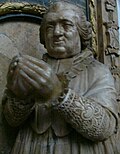 Plastic of the bishop's epitaph altar |
 Depiction of the coat of arms on the epitaph |
| 68 | Joseph Count von Stubenberg | 1791 | 1824 | The bishopric was secularized under Joseph in 1802 . He was thus the last Prince-Bishop and then until 1824 Apostolic Administrator and at the same time Archbishop of Bamberg (1818-1824). |
 Depiction on a silver thaler from 1796 |
 Episcopal coat of arms on the reverse of the coin |
| 69 | Peter blows | 1824 | 1825 | Petrus came from the Pustet publishing and printing family, he was the uncle of Friedrich Pustet , the founder of Friedrich Pustet KG . In the Augustinian Canons pipe his ecclesiastical career began and he became his last provost. He died a year after his appointment as bishop. |
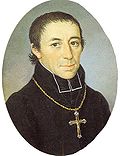
|

|
| 70 | Johann Friedrich Oesterreicher | 1825 | 1835 | Johann Friedrich was initially titular bishop of Doryla (1823-1825) and auxiliary bishop of Bamberg . |
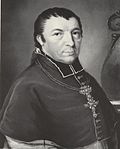
|
|
| 71 | Johann Martin Manl | 1835 | 1835 | Johann Martin was mainly Bishop of Speyer (1827–1835). There he appointed Franz Xaver Remling as cathedral vicar and his secretary, who as a historian also dealt with the most recent church history. Due to increasing internal differences, Johann Martin was granted a transfer to Eichstätt, where he died after only a few months. |

|
|
| 72 | Karl August Graf von Reisach | 1836 | 1846 | With the support of the Bavarian Interior Minister Karl von Abel, Karl August pursued an ultramontane -oriented church policy. After his time in Eichstätter he was Archbishop of Munich and Freising (1846-1856) and was finally taken over by Pope Pius IX. appointed cardinal to the Curia and thus called to Rome. He died in 1869. |

|
|
| 73 | Georg von Oettl | 1846 | 1866 | Georg taught the children of the Bavarian King Ludwig I and enjoyed the trust of the royal family. He contributed to an amicable solution to the conflict about the so-called " mixed marriages ". He was the recipient of numerous awards. |
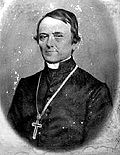
|
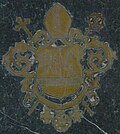
|
| 74 | Franz Leopold Freiherr von Leonrod | 1867 | 1905 | Franz Leopold accepted students from other dioceses in which the Kulturkampf had broken out openly. He visited all the parishes of the diocese personally several times. |

|
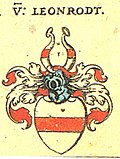
|
| 75 | Johannes Leo von Mergel | 1905 | 1932 | Johannes Leo was initially abbot of the Benedictine monastery in Metten . In 1906 he received the Bavarian nobility . The picture shows him on a death note . |

|
|
| 76 | Konrad Graf von Preysing | 1932 | 1935 | After his time as Bishop of Eichstätt he was Bishop of Berlin (1935–1950). The picture shows him on a postage stamp of the Deutsche Bundespost Berlin . |
 Depiction on a postage stamp of the Deutsche Bundespost Berlin from 1980 |
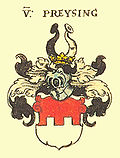
|
| 77 | Michael Rackl | 1935 | 1948 | Michael defended Christian positions against the National Socialist ideology. At the end of the war he worried about the integration of expellees, he offered many expelled priests work in the diocese. |

|
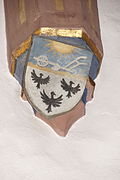
|
| 78 | Joseph Schröffer | 1948 | 1967 | After his time as Bishop of Eichstätt, Joseph moved to the Roman Curia as Secretary of the Congregation for Catholic Education in 1967 and was appointed Titular Bishop of Volturnum in 1968 . As a bishop, he founded the St. Gundekar-Werk to promote social housing and promote the settlement of displaced people. |

|
|
| 79 | Alois brake | 1968 | 1983 | After his resignation, Alois Brems was administrator in 1983 . He died in 1987. | ||
| 80 | Karl Braun | 1984 | 1995 | During his time as Eichstätt Bishop Braun was Grand Chancellor of the Catholic University of Eichstätt . He was then Archbishop of Bamberg (1995-2001). For his work he received the Order of Merit of the Federal Republic of Germany and the Bavarian Order of Merit . |
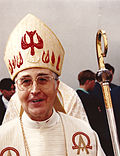
|

|
| 81 | Walter Mixa | 1996 | 2005 | Walter Mixa was Bishop of Augsburg from 2005 to 2010 . From 2000 to 2010 he also held the office of German military bishop . He was the second Grand Chancellor of the Catholic University of Eichstätt-Ingolstadt. |

|

|
| 82 | Gregor Maria Hanke | 2006 | With the appointment of Benedictine abbot Gregor Maria Hanke, the tradition continued that, with brief interruptions, a diocese in the area of the Bavarian Bishops' Conference is always occupied by a Benedictine. Hanke was the third Grand Chancellor of the Catholic University of Eichstätt-Ingolstadt and the last to hold this office in personal union. On September 30th, 2010 he transferred this office to the chairman of the Freising Bishops' Conference. |

|

|
See also

- List of the bishops of Augsburg
- List of the bishops of Regensburg
- List of the canons of Eichstätt
- List of the archbishops and bishops of Bamberg
literature
Specialist literature
- Franz Heidingsfelder : The regests of the bishops of Eichstätt (until the end of the reign of Bishop Marquart von Hagel in 1324) . Palm & Enke Erlangen 1938.
- Klaus Kreitmeir: The bishops of Eichstätt. Publishing house of the church newspaper Eichstätt. Eichstatt 1992.
- Alfred Wendehorst : The diocese of Eichstätt. Volume 1: The row of bishops until 1535 . Series: Germania Sacra - New Episode 45 . Berlin 2006. ISBN 978-3-11-018971-1 .
Historical sources
- The " Pontifical Gundekarianum ". Facsimile edition of Codex B 4 in the diocesan archive of Eichstätt. Two volumes., Facsimile volume, 46 × 37 cm, 82 pages, 37 of which are in color, commentary volume with contributions by Brun Appel, Andreas Bauch, Walter Dürig, Johann Konrad Eberlein , Monika Fink-Lang, Helmut Flachenecker , Hermann Hauke, Dietmar von Hübner, Klaus Kreitmeir, Ernst Reiter and Stefan Weinfurter, bibliography by Maria Mengs, 28 × 20 cm, 199 pages with 9 illustrations and 1 frontispiece, Verlag Reichert 1987.
Individual evidence
- ↑ a b is not included in the official list of bishops
